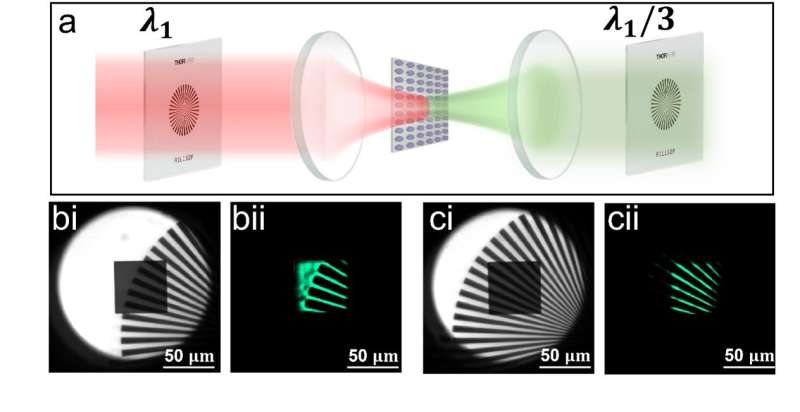All-optical, near-infrared imaging via ultra-thin structured films

Near-Infrared (NIR) vision detectors and cameras play an essential role in today’s high-tech tools for imaging, sensing and display technologies. Goggle- or binocular-based NIR cameras are particularly important for night vision, as well as medical and agriculture imaging. In conventional NIR cameras, the NIR light (700−2500 nm) is absorbed via a photocathode, leading to the discharge of electrons, which consequently strike an integrated flat screen, viewed by the eye or by an imaging sensor.
While such devices have proven effective in the abovementioned applications, they are bulky, heavy, monochrome and limited to certain wavelength bands. The latter is a major technological limitation because photocathodes are functional only in one of the following ranges: 400–1000nm, 1000–2500nm or >2500 nm. However, Z. Zheng and colleagues, in this paper, have demonstrated a thin film capable of covering all of these frequency bands without needing to convert the light to electrons and vice-versa.
In this work, researchers have employed the concept of nonlinear metasurfaces. Metasurfaces are arrays of nanoscale resonators that can manipulate light properties, including the light’s propagation direction, intensity, and wavelength (/color). Metasurfaces, capable of converting the wavelength of light, are known as nonlinear metasurfaces. In this paper, a nonlinear metasurface composed of a thin silicon film is exploited. The film accommodates carefully designed and fabricated nanoscale holes, i.e., membrane geometry, that strongly resonate with the incoming light. After illuminating the designed metasurface with a NIR light, it generates a new color at 1/3 of the original wavelength via a nonlinear process, so-called third harmonic generation (THG).
By controlling the symmetry of the array of nano-holes, the researchers have demonstrated a versatile tool for tunning the light wavelengths and intensities, which is ultimately used for NIR imaging. The image above illustrates the concept of NIR imaging for arbitrary objects. As a demonstration, the NIR light around telecommunication wavelength (1512 nm) passes through a sector star target and gets converted into the visible signal (504nm) via the metasurfaces. The images shown in 1(bii and cii) are formed on the CCD camera.
Such an innovative approach for NIR imaging is widely expandable to large frequency bands and multi-color processes. Worth noting that the exploited material, i.e., silicon, is being heavily used in the CMOS industry today. Therefore, mass production of silicon metasurfaces does not need heavy investments. Moreover, silicon does not absorb NIR light in wavelengths >1000 nm, so heating is not a concern. Last but not least, silicon is a centrosymmetric material. Therefore nonlinear silicon metasurfaces can be used for other third-order nonlinear interactions beyond THG.
For example, by using a process called four-wave mixing, one can involve several wavelengths in the NIR and visible ranges, enabling the generation of colorful images. In other words, the demonstrated platform in this paper is a building block for the next generation of thin, inexpensive, broadband, and colorful NIR cameras and detectors.
The work is published in the journal Opto-Electronic Advances.
More information:
Ze Zheng et al, Third-harmonic generation and imaging with resonant Si membrane metasurface, Opto-Electronic Advances (2023). DOI: 10.29026/oea.2023.220174
Provided by
Compuscript Ltd
Citation:
All-optical, near-infrared imaging via ultra-thin structured films (2023, May 26)
retrieved 26 May 2023
from https://phys.org/news/2023-05-all-optical-near-infrared-imaging-ultra-thin.html
This document is subject to copyright. Apart from any fair dealing for the purpose of private study or research, no
part may be reproduced without the written permission. The content is provided for information purposes only.
For all the latest Science News Click Here
For the latest news and updates, follow us on Google News.

